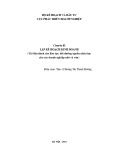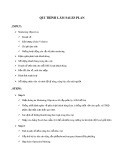
http://www.iaeme.com/IJM/index.asp 54 editor@iaeme.com
International Journal of Management (IJM)
Volume 9, Issue 6, November- December 2018, pp.54-60 , Article ID: IJM_09_06_005
Available online at http://www.iaeme.com/ijm/issues.asp?JType=IJM&VType=9&IType=6
Journal Impact Factor (2016): 8.1920 (Calculated by GISI) www.jifactor.com
ISSN Print: 0976-6502 and ISSN Online: 0976-6510
© IAEME Publication
EXPLORING AND DESIGNING AN
APPROPRIATE SUCCESSION PLANNING
MODEL
Dr. Revathy Shivashankaran
Assistant Professor
School of Commerce and Management Studies,
Dayananda Sagar University,
Bengaluru, Karnataka, India.
Dr. Anni Arnav
Assistant Professor
School of Commerce and Management Studies,
Dayananda Sagar University,
Bengaluru, Karnataka, India
ABSTRACT
"Building a deep leadership pipeline is a priority for any progressive and growth-
driven organisation as it is a critical element towards building a lasting institution
which outlives its founders."
As rightly said by Rituparna Chakraborty, Co-founder and Executive Vice-
President, TeamLease Services, Succession Planning is one of the major concerns of
today’s business organizations. Succession planning is a talent management process
that builds a pool of trained workforce who are ready to fill key roles when leaders
and other key employees step down. Succession planning relies on a large pool of
talented workforce ranging from entry-level to senior leadership who are being
prepared for key roles. These employees have the right skills, energy and leadership
qualities that will benefit the company across a spectrum of roles, departments and
seniority levels. Organizations with succession planning programs in place foster a
talent-oriented culture by recruiting skilled employees and top talent. Once recruited,
businesses focus on developing these employees’ skills, expertise and knowledge so
they are prepared to take on leadership roles in the event of organizational growth,
talent loss or management turnover. This research study focuses on exploring the most
appropriate succession planning process and thereby designing an industry-specific
model.
Keywords: Succession planning, talent management, organizational growth,
leadership.

Dr. Revathy Shivashankaran and Dr. Anni Arnav
http://www.iaeme.com/IJM/index.asp 55 editor@iaeme.com
Cite this Article: Dr. Revathy Shivashankaran and Dr. Anni Arnav, Exploring and
Designing an Appropriate Succession Planning Model, International Journal of
Management, 09 (6), 2018, pp. 54-60
http://www.iaeme.com/IJM/issues.asp?JType=IJM&VType=09&IType=6
1. INTRODUCTION
Succession planning and strengthening of the leadership channel are the top talent concerns
for corporate executives globally, according to a study by Deloitte. Executives worldwide
predict leadership shortages in the approaching years and are looking at various ways to
accelerate leadership development within their organizations.
The report, titled, 'Talent Edge 2020: Redrafting Talent Strategies for the Uneven
Recovery' says, despite a new wave of uncertainty, many leading companies are reshaping
their talent strategies. As a result, organizations across the globe are seeking new sources of
growth and are tailoring talent plans to address differing regional needs to support effective
talent strategies and business operations.
Succession Planning is the process of identifying and tracking high-potential employees
who will be able to fill top management positions when they become vacant. Succession
planning is an ongoing process that identifies necessary competencies, then works to assess,
develop, and retain a talent pool of employees, in order to ensure a continuity of leadership
for all critical positions. Succession planning is a specific strategy, which spells out the
particular steps to be followed to achieve the mission, goals, and initiatives identified in
workforce planning. It is a plan that managers can follow, implement, and customize to meet
the needs of their organization, division, and/or department.
Succession can be from within or from outside the organization. Succession by people
from within gives a shared feeling among employee that they can grow as the organization
grows. Therefore organization needs to encourage the growth and development with its
employee. They should look inward to identify potential and make effort to groom people to
higher and varied responsibilities. In some professionally run large organizations, managers
and supervisor in every department are usually asked to identify three or four best candidate
to replace them in their jobs should the need arise. However, the organization may find it
necessary to search for talent from outside in certain circumstance. For example, when
qualified and competent people are not available internally, when it is planning to launch a
major expansion or diversification programmes requiring new ideas etc. Complete
dependence on internal source may cause stagnation for the organization. Similarly complete
dependence on outside talent may cause stagnation in the career prospects of the individual
within the organization which may in turn generate a sense of frustration.
Succession planning provides managers and supervisors a step-by-step methodology to
utilize after workforce planning initiatives have identified the critical required job needs in
their organization. Succession planning is pro-active and future focused, and enables
managers and supervisors to assess, evaluate, and develop a talent pool of individuals who are
willing and able to fill positions when needed. It is a tool to meet the necessary staffing needs
of an organization/department, taking not only quantity of available candidates into
consideration, but also focusing on the quality of the candidates, through addressing
competencies and skill gaps.
In a recent interview, Tim Cook, CEO of Apple shared his view on succession
planning saying, “I see my role as CEO to prepare as many people as I can to be CEO, and
that’s what I’m doing. And then the board makes a decision at that point in time.”
Apple has seen the importance of having a proper succession plan in place to ensure that there
are no problems when it comes to leadership in the company.

Exploring and Designing an Appropriate Succession Planning Model
http://www.iaeme.com/IJM/index.asp 56 editor@iaeme.com
2. LITERATURE REVIEW
Robert Barnett and Sandra Davis (2008) have discussed that the prevalence of formalized
succession planning practices in organizations are increasing, largely due to changing
demographic and related trends. A practical, five-step approach to succession planning was
proposed to help organizations to look into and prepare for the future more effectively,
specifying the future requirements for their leaders.
Ali Deghanpour, Ahmadreza Sanjari Karahrudi and Vahid Nasehifar (2011) evaluate
the effects of succession planning as an organizational level intervening program on career
attitudes as individual level variables. A 22-item questionnaire was developed to measure the
extensiveness of succession planning. Also the scale for measuring succession planning
extensiveness was developed which was used to gain a better understanding of status quo of
succession planning in organizations and gap analysis which is generally one of the early
stages of every organizational development project.
Susan D Hewitt’s (2009) purpose is to raise the profile of deep succession planning to
identify key talent. Older workers are forming a significant proportion of the workforce. This
cohort could be lost to retirement leaving industry and commerce short of talent. The main
implications of this paper are that organization‐deep succession planning is a complex process
requiring commitment and long term planning at all levels. Without a thorough analysis of
age and skill profile no workable plan can be made.
John F. LeCounte, Leon C. Prieto and Simone T. A. Phipps Middle (2017) have
expressed their view to review succession planning for the role of chief executive officers
(CEO) in organizations. They emphasise the importance of talent management policies and
practices as it relates to leadership pipelines, and provide a conceptual framework that
organizations can adopt to ensure that they will always be prepared for CEO succession and
maintain a competitive edge.
Mrs.Ch.Gowthami (2012) opines that succession planning process is an ongoing
development of employees that ensures a smooth transition and minimal loss of efficiency
when a vacancy occurs in the department. She highlights the initiatives taken by the
organizations in identifying their successor. The study depicts the extent of Succession
Planning in organizations in select countries like USA, Canada and India.
E.Michael Donner III, Daniel Gridley, Sidney Ulreich and Edward I Bluth (2017)
have putforth their view that transition of leadership within radiology practices is often not a
planned replacement process with formal development of potential future leaders. A
structured system to accomplish succession planning is required, including mentoring,
structured socializing, and formal education with training programs including accountability
of the program through the group leadership. To ensure the successful development of a
succession plan, leadership must commit to develop and execute a strategic succession plan.
A.H.Masthan Ali and Dr. P.Premchand Babu (2015) have analysed the fact that
Software Organizations often fail to utilize lower level and middle level personnel effectively
for leadership development and succession planning systems, and many execute these critical
practices through separate human resource functions that shift the responsibility for leadership
development away from line managers.
Ahsan M (2018) has done his research to analyze the impact of Effective Recruitment and
Selection along with succession planning towards leadership development, employee
retention and talent management towards organization effectiveness in Pakistan. How
recruitment and selection play the key role in the contribution towards leadership
development, employee retention and talent management in Pakistan.

Dr. Revathy Shivashankaran and Dr. Anni Arnav
http://www.iaeme.com/IJM/index.asp 57 editor@iaeme.com
Dr.Suruchi Pandey and Mr.Deepesh Sharma (2014) have emphasized the need for
succession planning. The talent management process attracted the most investment. The
management should consider creating a talent pool at initial level, which can be developed
over time to meet talent needs. The talent pool should be based on two aspects, i.e.
performance and potential of employee. Performance rating can be used as input for
performance. Succession planning as a process is dependent on integration with other process
to give an efficient output.
3. STATEMENT OF THE PROBLEM
“Exploring and designing an appropriate succession planning model” is the title of the study.
Succession planning establishes a process to recruit employees, develop their skills, and
prepare them for advancement, all while retaining them to ensure a return on the
organization's training investment. Succession planning involves understanding the
organization's long-term goals and objectives, identifying employee development needs, and
determining trends. The purpose of succession planning is to identify and develop people to
replace current incumbents in key position for a variety of reasons like superannuation,
resignation, promotion, diversification and creation of new position. This study would
necessitate the process of designing a model to succession planning.
4. OBJECTIVES OF THE STUDY
The prime objectives of this study are:
Find out the significant competencies required for succession planning process.
Explore the effective succession planning process relationships.
Design a model for succession planning process.
5. SIGNIFICANT COMPETENCIES REQUIRED FOR SUCCESSION
PLANNING PROCESS
Significant and necessary competencies need to be identified for succession planning to
assess, develop, and retain a talent pool of employees in order to ensure a continuity of
leadership for all critical positions. The following competencies may be considered for
succession planning in four main components, including:
i. Personal attitudes: Self-confidence, attitude towards development, professional ethics,
creativity and innovation, attitude towards change and learning;
ii. Intellectual foundations: Business thinking, understanding the job role the extent of
thinking, judgments and decision makings;
iii. Interpersonal skills: Teamwork, customer orientation, communication, influence, and
relationships;
iv. (iv) People and tasks Management: Performance management, conflict management,
leadership and training the others (Abolala’ei & Ghafari, 2007).
v. Boak & Coolincan (2001) in their review identified six leadership competencies that
each one represents a set of behaviors. They include: strategic activity, influencing the
others, actions, decisions, team reformation with high performance, assessment and
learning.
6. EFFECTIVE SUCCESSION PLANNING PROCESS
Succession planning is any effort designed to ensure the continued effective performance of
an organization, division, department, or work group by making provisions for the
development, replacement and strategic application of key people over time. It aims to attract

Exploring and Designing an Appropriate Succession Planning Model
http://www.iaeme.com/IJM/index.asp 58 editor@iaeme.com
the best talent, retain those individuals, and develop them through well-targeted development
efforts. Succession planning helps build the bench strength of an organization to ensure the
long-term health, growth and stability. An effective successive planning process may contain
the following steps:
1. Establishment of measurable goals to guide the succession planning program with
close alignment of the measurable goals of the succession planning program to the
organization's measurable strategic goals is necessary;
2. Recalibrating the succession planning program goals on an annual basis in accordance
with the changing competitive and organizational conditions and priorities is
mandatory;
3. Preparation of the current job descriptions is required so that the work to be performed
is clear;
4. Preparation of competency models according to the hierarchical level on the
organization chart by using a rigorous examination of objective performance
requirements should be performed. Planning for future competencies that are
necessary to achieve future strategic goals will ensure all competency models are clear
and measurable;
5. Careful definition of the roles to be played by each key stakeholder group in the
succession planning process is essential. Key stakeholders include the Board of
directors, CEO, senior executives, middle managers, supervisors, and even workers.
Keeping senior managers and other stakeholders engaged in the succession planning
program by establishing clear, measurable accountabilities would be of great help to
the organization;
6. Establishment of talent pools by levels based on the strategic strengths of the
organization is necessary;
7. Taking an inventory of the talent pool will ensure that individual strengths and areas
for improvement are recognized. Conduction of talent reviews on a continuing basis
will ensure that promotable individuals are being properly developed over time.
8. Evaluation of the entire succession planning program on a regular (usually annual)
basis would help to compare processes and results against the measurable succession
planning goals established at the beginning of the yearly planning cycle.
7. SUCCESSION PLANNING PROCESS RELATIONSHIP MODEL
Succession planning is all about the preparations of an organization in order to tackle
uncertainties in the future and to be ready for business continuity planning in crisis. The
situation of 2008 recession can be recalled to understand as how many organizations were
prepared to handle to such emergency. The succession planning process and the different
aspects in it are interrelated to fine tune an individual to suit into the requirement of the
particular organization and deal with caution. The below model is suggested to cater to this
need. The succession planning process relationship model has three directions with creative
orientation, future orientation and competency orientation.


























